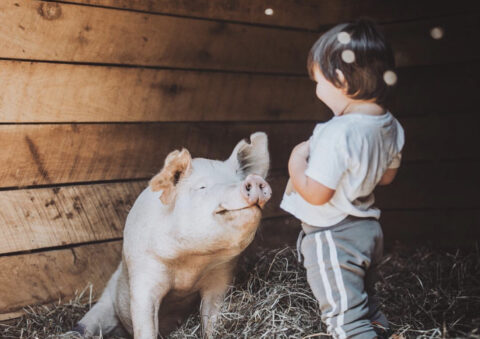News
Could Genetically Engineered Fungus Help Replace Animal Protein?
Breakthroughs•5 min read
Perspective
In the time you've spent reading this article, roughly 231,396 animals have been slaughtered for food.


Words by Julie Knopp
In April of 2020, an Iowa pig farmer received a cold call from an animal advocate in California. The call was part of an effort to connect farmed animals with rescue organizations amidst widespread mass slaughters due to the pandemic. Soon the farmer relinquished two healthy 7-week-old piglets—who may have otherwise faced untimely deaths—to Farmaste Animal Sanctuary in Lindstrom, Minnesota. At Farmaste, the two piglets, later named Phoebe and Charlotte, would feel grass and see the sky for the very first time.
The importance of humans’ bonds with farmed animals like Phoebe and Charlotte is part of the inspiration for World Day for Farmed Animals (WDFA), which is observed each year on October 2 in honor of Gandhi’s birthday. WDFA was established in 1983 to recognize and mourn the annual loss of more than 60 billion cows, pigs, chickens, and other animals who suffer and die for human consumption. WDFA provides an opportunity for people across the globe to stand up in defense of these often invisible animals, the vast majority of whom spend their short lives on factory farms. Most of them never see sunlight and live in cramped cages, often without enough space to turn around or lie down. On WDFA, thousands of people around the world will hold public vigils or fast in solidarity with the many animals who are starved on their long journeys to slaughter.
Observance of WDFA is now particularly relevant, as 2020 will likely prove to be the deadliest year yet for farmed animals. Workforce shortages and supply chain disruptions are leaving many farmers with animals with no place to go. Estimates suggest that millions of chickens and hogs have already been slaughtered and dumped without being processed into food. The culled animals are not the only victims; farmers are suffering intense emotional and economic burdens, and slaughterhouse workers are experiencing some of the highest rates of coronavirus infection of any industry due to poor working conditions. The widespread “depopulation” of farmed animals in 2020 is drawing heightened public attention to an industry that values profit over the welfare of sentient beings.
My home state of Minnesota, which ranks first nationwide in turkey production and third in hog production, is playing a significant role in making this year particularly deadly for animals. In May, the Minneapolis Star Tribune reported that Minnesota farmers were euthanizing 10,000 pigs per day. Minnesota animal health officials have leased plots of land of up to 100 acres for use as composting sites for dead pigs who are not processed into food. Some Minnesota farmers have been using inhumane culling methods such as shutting down ventilation systems, which entail shutting off airways to holding buildings and piping in steam to essentially cook the captive animals alive. Local animal advocates are planning a candlelight vigil in Minneapolis for WDFA to honor the billions of animal lives lost in Minnesota and worldwide in 2020.
WDFA is just one day, but ongoing action from all of us is necessary to make meaningful progress for animals. Consumers can reduce animal suffering by choosing to eat more plant-based foods. Animal farmers can transition to raising crops to respond to the growing consumer demand for plant-based products. Voters can encourage public officials to support legislation that improves animal welfare. By advocating for systemic change and reducing individual demand for animal products, each of us can play a role in creating a better future for animals.
In the time you’ve spent reading this article, roughly 231,396 animals have been slaughtered for food. “These animals have personalities, they love, they’re sad, they build family units,” remarks Farmaste Animal Sanctuary founder Kelly Tope, who rescued piglets Phoebe and Charlotte. Tope acknowledges that her organization can provide freedom for only a finite number of animals, yet she and many others hope that WDFA can play a role in creating a world where all animals experience freedom.
According to Tope, “We need to break down the belief that [farmed animals] are any different than the [companion] animals we love in our homes. When Phoebe and Charlotte went outside for the first time, it was one of those moments that I’ll cherish and hold on to forever.”